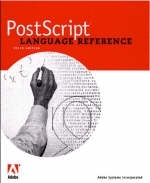
PostScript Language Reference
Addison Wesley (Verlag)
978-0-201-37922-8 (ISBN)
- Titel ist leider vergriffen;
keine Neuauflage - Artikel merken
The PostScript language is widely recognized as the industry standard for page description. Incorporated into a broad range of printers, imagesetters, and computer displays, PostScript describes exactly how text, sampled images, and graphics will appear on a printed page or on a computer screen. The PostScript Language Reference, known as the Red Book, is the complete and authoritative reference manual for the PostScript language. Prepared by Adobe Systems Incorporated, the creators and stewards of the PostScript standard, it documents the syntax and semantics of the language, the Adobe imaging model, and the effects of the graphics operators. This Third Edition has been updated to include LanguageLevel 3 extensions, which unify a number of previous extensions and introduce many new features, such as high-fidelity color, support for masked images, and smooth shading capabilities.Book Highlights: *Explains fundamentals of the PostScript language, graphics, fonts, device control, and rendering *Organizes all PostScript operators through LanguageLevel 3, both by function and alphabetically *Describes operands, results, side effects, and possible errors for each operator *Appendices include numerous useful tables and other valuable information The Red Book is the definitive resource for all PostScript programmers.
0201379228B04062001
Adobe Systems Incorporated, founded in 1982, is a leading provider of graphic design, publishing, and imaging software for Web and print production, and the second-largest desktop software company in the world. The company builds award-winning software solutions for Web and graphic designers, professional publishers, document-intensive organizations, business users, and consumers. 0201379228AB09252001
Preface.
1. Introduction.
About This Manual.
Evolution of the PostScript Language.
LanguageLevel 3 Overview.
Related Publications.
Copyrights and Trademarks.
2. Basic Ideas.
Raster Output Devices.
Scan Conversion.
Page Description Languages.
Using the PostScript Language.
3. Language.
Interpreter.
Syntax.
Data Types and Objects.
Stacks.
Execution.
Overview of Basic Operators.
Memory Management.
File Input and Output.
Named Resources.
Functions.
Errors.
Early Name Binding.
Filtered Files Details.
Binary Encoding Details.
4. Graphics.
Imaging Model.
Graphics State.
Coordinate Systems and Transformations.
Path Construction.
Painting.
User Paths.
Forms.
Color Spaces.
Patterns.
Images.
5. Fonts.
Organization and Use of Fonts.
Font Dictionaries.
Character Encoding.
Glyph Metric Information.
Font Cache.
Unique ID Generation.
Type 3 Fonts.
Additional Base Font Types.
Font Derivation and Modification.
Composite Fonts.
CID-Keyed Fonts.
6. Device Control.
Using Page Devices.
Page Device Parameters.
In-RIP Trapping.
Output Device Dictionary.
7. Rendering.
CIE-Based Color to Device Color.
Conversions among Device Color Spaces.
Transfer Functions.
Halftones.
Scan Conversion Details.
8. Operators.
Operator Summary.
Operator Details.
Appendix A. LanguageLevel Feature Summary.
LanguageLevel 3 Features.
LanguageLevel 2 Features.
Incompatibilities.
Appendix B. Implementation Limits.
Typical Limits.
Virtual Memory Use.
Appendix C. Interpreter Parameters.
Properties of User and System Parameters.
Defined User and System Parameters.
Details of User and System Parameters.
Device Parameters.
Appendix D. Compatibility Strategies.
The LanguageLevel Approach.
When to Provide Compatibility.
Compatibility Techniques.
Installing Emulations.
Appendix E. Character Sets and Encoding Vectors.
Times Family.
Helvetica Family.
Courier Family.
Symbol.
Standard Latin Character Set.
StandardEncoding Encoding Vector.
ISOLatin1Encoding Encoding Vector.
CE Encoding Vector.
Expert Character Set.
Expert Encoding Vector.
ExpertSubset Encoding Vector.
Symbol Character Set 786.
Symbol Encoding Vector.
Appendix F. System Name Encodings.
Appendix G. Operator Usage Guidelines.
Bibliography.
Index. 0201379228T04062001
| Erscheint lt. Verlag | 18.8.1999 |
|---|---|
| Zusatzinfo | illustrations |
| Verlagsort | Boston |
| Sprache | englisch |
| Maße | 190 x 235 mm |
| Gewicht | 1570 g |
| Themenwelt | Mathematik / Informatik ► Informatik ► Programmiersprachen / -werkzeuge |
| ISBN-10 | 0-201-37922-8 / 0201379228 |
| ISBN-13 | 978-0-201-37922-8 / 9780201379228 |
| Zustand | Neuware |
| Haben Sie eine Frage zum Produkt? |
aus dem Bereich


